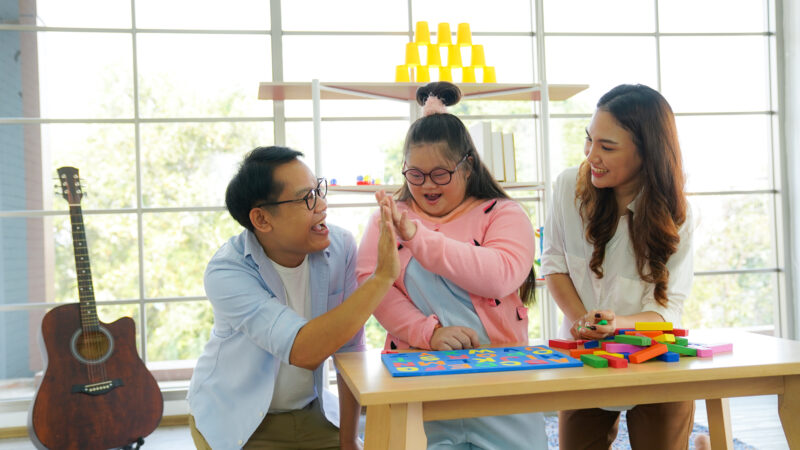
Starting a Special Needs Ministry—
Many of us feel overwhelmed when it comes to the idea of starting up a special needs ministry. We may think, “I don’t have any training in that area!” In the same breath, we realize that we simply can’t leave any children out, and so, however fearfully, we dive in.
I hope that in the next few paragraphs I can help calm your fears and point you in the right direction. Special needs ministry is really about excellent hospitality. A simple definition of hospitality is the act of being friendly and welcoming to guest and visitors. That’s not so scary, is it? As the church, we offer a warm and loving welcome, not just for some, but for all whom God brings through our doors.
So then, let us start this unique ministry simply. Ask yourself, “Whom has God brought to us, to our children’s ministry, that needs some extra help or support to be welcomed and assimilated well? Once you’ve identified some children and families needing some extra support, you are ready to go!
I like to think of these steps:
The first step is building on what you have already done. Observe. Sit in on classrooms, watch during church service, keep your eye out during family events and identify the children who need extra support and observe how they are functioning currently and how their peers and teachers interact with them.
Next, communicate! Find out what your teachers are already doing to accommodate the needs of a child. Ask how they are doing. Of course, the most important communication will be with the parents. Find out what strengths and weaknesses their child has. What motivates their child and what triggers their child? What supports would they love for their child and what things are not needed? Ask Mom and Dad what the church could do to help enfold them into the community and life of the church.
From here, you are going to make a plan. Take all the information you have and pray for the Lord to guide you as you make a plan to support your children. But to make a plan, you will need some tools! So, let’s turn our attention to those!
One of the most common and effective tools is the special buddy. This person goes to class or sits in church with the child, offering assistance in a variety of ways. This person can help contain the child who frequently escapes, or the buddy may notice what stimulus overwhelms a child, taking him or her for a walk down the hall before behavior escalates. Perhaps the special buddy sits with the child, playing quietly when he or she is unable to sit with the other children during the lesson, making sure the child still hears the story, but is not distracting to others. Depending on the child’s needs, this can be a great place for high school students to serve. It’s also a wonderful role for parents with grown children who have lots of parenting experience from which to draw.
Another great tool is the yearly letter. Ask the parents to write an open letter to volunteers and teachers who will be working with their child. Have them explain any diagnosis and weaknesses their child may have. Just as importantly, have them explain their child’s strengths and interests. They should share what things work well for their child and what things trigger their child. Share this letter with the appropriate people. Then save it in your computer files. At the beginning of the next ministry year, send it back to the parents for an update. This way they don’t have to start from scratch each year. Parent input is invaluable!
Many children benefit from a visual schedule. Post this on a bulletin board, tape to the wall, or attach with Velcro to a ribbon hanging on the wall. The visual schedule has pictures that represent each activity (children sitting in a circle listening to the teacher, folded hands for prayer, a music for singing, crayons and a bottle of glue for craft time, etc.) When the class arrives the teacher says, “Here is what we are doing today,” as he or she puts the pictures up in order. At each transition, the teacher can point to the schedule to help children prepare for what comes up next. This is very helpful for children who have difficulty when it comes to moving from one activity to the next. You can find pictures on the internet, draw your own, or use a great resource from Engaging Disability (Go to “shop“ and check out the Church Visual Schedule Digital Download).
Ultimately, we would love to have our children with disabilities participate in the entire class. Many can, but others may need this big goal broken down into small goals. For instance, the big goal is to have the child participate for the full length of Sunday School in all classroom activities. Break that down into small goals and celebrate each accomplishment. Your first goal may be to have the child sit in the circle and listen during the Bible lesson. Break that down into smaller chunks. The first goal may be to have the child put away his or her toys and come to the circle when the teacher directs. Every time the student does that, you might give a small reward (a goldfish cracker, a high-five, or a check mark on a card—whatever motivates the child). Your next goal may be to have the student sit in the circle during singing. You get the idea!
Some children may have significant needs, beyond what you feel you can meet. Don’t let this discourage you. You are not alone in this endeavor! Pray with your Children’s Ministry Team. Pray with their parents. Reach out to your local special education teachers. And of course, contact Engaging Disability. Remember, God has brought you each child who comes through your doors. He uses us in our weakness and so we trust in Him to provide!
Visit Lisa’s training video on this subject on our children’s ministry website.

Lisa Updike, Director of Children’s Ministries at Covenant Presbyterian in Harrisonburg, VA, has been in love with Jesus since she was a little girl and has always been passionate about sharing the gospel with others. She has extensive ministry experience which includes homeschooling, teaching in Christian Schools, working as a learning disabilities therapist, leading children’s choirs, and spearheading children’s programs in several churches over the last 30 years. Lisa and Kevin have 4 children (3 through adoption).
